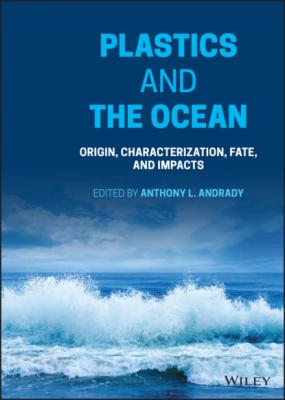Plastics and the Ocean. Группа авторов
Читать онлайн.| Название | Plastics and the Ocean |
|---|---|
| Автор произведения | Группа авторов |
| Жанр | Химия |
| Серия | |
| Издательство | Химия |
| Год выпуска | 0 |
| isbn | 9781119768418 |
These FRs work in the vapor or gas state and interfere with the radical mechanism of the combustion process. Plastics, such as polyethylene (PE), high‐impact polystyrene, ethylene‐vinyl acetate copolymer, and acrylonitrile‐butadiene‐styrene (ABS) copolymer, use PBDEs as FRs (Andrady and Rajapakse 2019; Delva et al. 2018; Rahman et al. 2001). Recently, many PBDEs, such as penta‐BDE, octa‐BDE, and deca‐BDE, have been phased out due to their significant persistence and toxicity. New BFRs, such as 1,2‐bis(2,4,6‐tribromophenoxy) ethane, have been developed as substitutes (Sun et al. 2019). Phosphate‐based FRs, such as tri(2‐chloroethyl) phosphate (TCEP) or tris(2‐ethylhexyl)phosphate are char formers that produce phosphoric acids that react with the substrate to generate a char that protects the polymer itself from combustion (Ambrogi et al. 2017; Samani and van der Meer 2020). Metal hydrate FRs are typically aluminum trihydroxide and magnesium hydroxide that hydrates decompose under high heat to release water, preventing propagation (Innes and Innes 2002).
Table 2.2 Eight of the most commonly used phthalate plasticizers in PVC.
Source of data: Zero Breast Cancer. (2014). “Phthalates: The Everywhere Chemical.” Retrieved October 8 2020, from https://www.niehs.nih.gov/research/supported/assets/docs/j_q/phthalates_the_everywhere_chemical_handout_508.pdf.
| Name | Abbreviation | Common metabolites | Banned in toys and childcare articles in EU | Banned in U.S. toys or childcare articles |
|---|---|---|---|---|
| Butyl benzyl phthalate | BBP | Mono benzyl phthalate (MBzP) | X | X |
| Di‐n‐butyl phthalate | DnBP | Mono‐n‐butyl phthalate (MnBP); mono‐isobutyl phthalate (MiBP) | X | X |
| Di‐(2‐ethylhexyl) phthalate | DEHP | Mono‐(2‐ethylhexyl) phthalate (MEHP); mono‐(2‐ethyl‐5‐hydroxyhexyl) phthalate (MEHHP); mono‐(2‐ethyl‐5‐oxohexyl) phthalate (MEOHP); mono‐(2‐ethyl‐5‐carboxypentyl) phthalate (MECPP) | X | X |
| Diethyl phthalate | DEP | Monoethyl phthalate (MEP) | ||
| Di‐isodecyl phthalate | DiDP | Mono‐(carboxynonyl) phthalate (MCNP) | X | |
| Di‐isononyl phthalate | DiNP | Mono‐isononyl phthalate (MiNP) | X | X |
| Di‐n‐hexyl phthalate | DnHP | X | ||
| Di‐n‐octyl phthalate | DnOP | Mono‐(3‐carboxypropyl) phthalate (MCPP); mono‐n‐octyl phthalate (MOP) | X |
Note: Several phthalates have been banned by the European Union (EU) or the United States for use in toys or childcare articles at concentrations >0.1% (ZBC 2018).
Figure 2.1 Chemical structures of (a) PBDE, (b) HBCD, (c) TBBPA, and (d) PBB.
FRs have a high propensity to migrate out of the plastic into surrounding environments. Some FRs are used as mixtures of congeners, such as commercial PBDEs, with certain congeners more toxic than others. Although some commercial PBDEs (penta‐BDE, octa‐BDE, and deca‐BDE) have been phased out (Sharkey et al. 2020), they will remain in the environment for many years because of their persistence.
2.2.3 Antioxidants
Plastic materials are organic substances that are susceptible to oxidative degradation. For example, polyolefins (i.e. PE, polypropylene) degrade by autoxidation, a cycle that can be slowed by the action of antioxidants. Throughout a plastic’s life cycle (i.e. production, processing, use, and disposal), the polymer is subjected to a variety of damaging stresses. This includes high temperatures and shear rates from the multiple melt compounding steps as the product is transformed from reactor powder or pellets into a finished article and ultimately processed again through recycling. In addition to temperature and shear, catalyst residues, entrained oxygen, and other types of impurities might also play a role in promoting further degradation of the polymer (Zweifel et al. 2001).
During these repeated heat histories, polymers undergo a series of free‐radical‐mediated oxidation reactions. These result in the formation of polymer hydroperoxides that thermally dissociate into additional free radicals (see Chapter 8 for detailed reactions). In addition to introducing oxygen‐containing functionalities into the plastic, the oxidative reactions also facilitate chain scission altering its average molecular weight (MW), MW distribution, and structure of the polymer backbone. When not stabilized adequately, the plastic will ultimately begin to lose its mechanical integrity; this will also limit the recyclability of the polymer and can lead to the formation of microplastics (Zweifel et al. 2001).
Antioxidants are used to prevent the formation of free radicals. Phenolic antioxidants scavenge oxygen‐centered free radicals, such as alkoxy‐, hydroxy‐, and peroxy‐type species, and prevent reaction with the polymer backbone (see Chapter 8). These substances include hindered phenols their and APs. Phosphites and thioesters are used to decompose the hydroperoxides into relatively inert products. These additives are used to impart longevity and stability in the plastic article. Since they are designed to remain active in the matrix for a long time, they continue to protect the article after disposal, which leads to long life spans of polymers in the environment. The most common antioxidants are listed in Table 2.3 along with their corresponding class and structures.
2.2.4 Heat Stabilizers
Heat stabilizers are added to plastics to protect the material from heat during processing and using the product. The most common application of heat stabilizers is in medical grade PVC where it is used at a concentration of 10–15% to protect the polymer during autoclaving (Sastri 2013). Due to the labile chlorine group, PVC is particularly susceptible to heat. Heat
